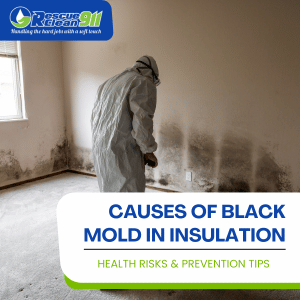If you notice mushrooms growing in your shower, taking immediate action for the prevention and removal of mushrooms in shower is critical.
These fungal growths can quickly spread, leading to structural damage, moisture problems, and potential health risks if left unaddressed.
Understanding why mushrooms appear in bathrooms, how to remove them safely, and how to prevent future growth is essential for every homeowner or property manager.
Prevention and Removal of Mushrooms in Shower – Tips & Tricks
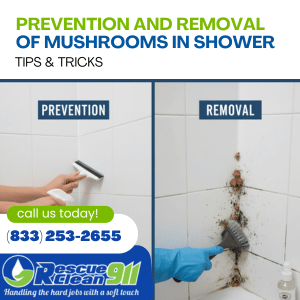 Mushrooms are a type of fungus that thrives in humid environments with excess moisture and poor ventilation.
Mushrooms are a type of fungus that thrives in humid environments with excess moisture and poor ventilation.
While many types are non-toxic, some mushrooms growing in the shower can pose serious health concerns if accidentally ingested or if their spores are inhaled. They commonly grow on organic materials like wood, drywall, or damp flooring, which act as a food source.
Bathrooms, especially showers, are particularly susceptible due to high humidity, excess moisture, and damp areas, all of which create an ideal environment for mushrooms and other fungi to thrive.
Common Types of Mushrooms Found in Bathrooms
Shaggy Mane: Non-toxic but can cause allergic reactions if spores are inhaled.
Crimini, Portabella, Shiitake: Generally safe but rarely found indoors.
Poisonous Varieties: Death Cap and Destroying Angel can appear in rare circumstances. Always avoid direct contact.
Factors That Promote Mushroom Growth in Bathrooms
Excess Moisture and High Humidity: Showers generate significant steam, raising humidity levels and creating damp conditions.
Poor Ventilation: Lack of a ventilation fan, exhaust fans, or open windows limits air circulation, allowing fungal growth to accelerate.
Heat: Warm environments encourage mushrooms to thrive by keeping moisture trapped.
Limited Light: Dark corners and under-sink areas are ideal for mushrooms and other fungi.
Organic Material: Wood, grout, and even towels left on the floor can act as a food source.
Related article: How to Deal with Mushrooms Growing from Ceiling
How to Prevent Mushrooms from Growing in Your Shower
Prevention is the most effective approach. Implementing preventative measures can stop mushrooms before they become a problem.
1. Address Moisture Issues Immediately
Fix water leaks promptly.
Dry damp areas after shower use.
Reduce moisture levels using towels or squeegees.
 2. Ensure Proper Ventilation
2. Ensure Proper Ventilation
Install a ventilation fan or exhaust fans in your bathroom.
Use adequate ventilation to reduce humidity levels.
Open windows when possible to improve air circulation.
Proper ventilation prevents further growth and discourages mushrooms from growing.
3. Maintain a Clean and Dry Bathroom
Perform regular cleaning with non-toxic solutions.
Keep your bathroom clean and free of organic debris.
Wipe surfaces dry to maintain a bathroom that is dry and mold-free.
If you find mushrooms growing in your bathroom, you can remove them by carefully pulling them up from the roots. You may also consider cleaning the area with a bleach solution to discourage future growth.
4. Reduce Conditions That Promote Fungal Growth
Limit the use of rugs or damp towels on floors.
Avoid storing wooden items directly on wet surfaces.
Keep humidity levels below 60% when possible.
These steps help prevent future growth and reduce the risk of mold. With these tips, you can safely remove mushrooms from your shower and keep them from returning!
How Mushrooms Affect Your Bathroom and Health
Mushrooms and mold growth are not just aesthetic issues; they present serious health risks and can cause:
Allergic reactions such as sneezing, skin irritation, or watery eyes.
Respiratory issues, including asthma flare-ups and lung irritation.
Structural damage from moisture weakens tiles, drywall, and wooden fixtures.
Mushroom spores, along with mold spores, can easily become airborne, promote fungal growth, and lead to further growth if left untreated.
Where Mushrooms Usually Appear in the Bathroom
Mushrooms can grow in many places, and the bathroom is no exception. They can often grow in the shower, as the warm and humid conditions are ideal for mushroom growth.
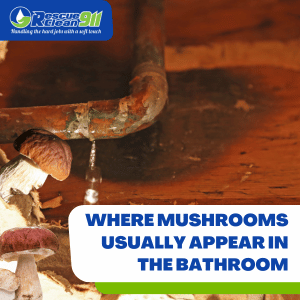 Mushrooms can be found in several high-risk areas:
Mushrooms can be found in several high-risk areas:
Shower floors and corners
Around sinks and faucets
Grout lines and caulking
Wooden or composite bathroom cabinets
Damp tile edges or wallpaper seams
Identifying the affected area early is crucial for preventing mushrooms and preventing recurrence.
If you notice mushrooms growing on your carpet, too, it’s a clear sign of excess moisture and potential mold growth, so addressing the source and cleaning thoroughly is essential.
How to Safely Remove Mushrooms from Your Shower
If mushrooms appear despite preventative measures, careful removal is essential. Avoid direct contact to prevent health issues.
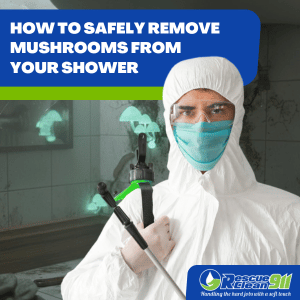 Step 1: Wear Protective Gear
Step 1: Wear Protective Gear
Use gloves and goggles to avoid direct contact with spores.
Consider a mask if dealing with large infestations to reduce respiratory issues.
Step 2: Identify the Type of Mushroom
Wet and slimy mushrooms may be poisonous. Call professional help.
Dry and firm mushrooms can be manually removed safely.
Step 3: Manual Removal and Cleaning
Pull mushrooms up from the roots to eliminate mold and prevent further growth.
Clean the affected area with a mold-killing solution or white vinegar.
Ensure surfaces are thoroughly dried after cleaning.
Step 4: Monitor for Recurrence
Perform regular inspections of showers, walls, and damp areas.
Address moisture problems promptly to prevent future growth.
Professional Help for Mushroom Infestations
Sometimes professional help is the safest and most effective option. Experts can:
Safely get rid of mushrooms and other fungi.
Treat the root cause of moisture damage.
Apply non-toxic solutions to prevent recurrence.
Conduct thorough inspections to stop mushroom growth and mold in other areas.
Calling professionals is particularly recommended if you encounter black mold, extensive fungal growth, or structural damage.
Related article: Causes Of Black Mold In Insulation And How to Prevent It
Additional Tips to Prevent Mushrooms in Your Bathroom
Regularly clean your shower and bathroom surfaces.
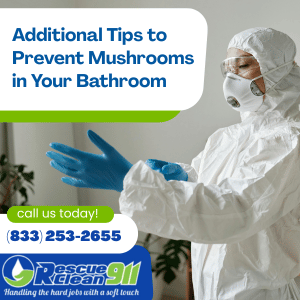 Keep your bathroom dry and free of excess moisture.
Keep your bathroom dry and free of excess moisture.Inspect leaks promptly to avoid moisture damage.
Ensure exhaust fans are functional and used during showers.
Remove standing water or puddles to prevent damp conditions.
Understanding the Root Cause
Eliminating mushrooms permanently requires addressing the root cause. Key considerations include:
Moisture problems from leaks, damp areas, or high humidity.
Poor ventilation that prevents adequate air circulation.
Organic materials left in damp conditions provide a food source.
Excess moisture that encourages further growth and mushrooms thrive.
Addressing these issues is crucial for long-term prevention and removal of mushrooms in the shower.
Health Concerns and Safety Precautions
Direct exposure to mushrooms or mold spores can lead to:
Allergic reactions like rashes or sneezing.
Respiratory issues, particularly in children or individuals with asthma.
Other health effects, such as eye irritation and fatigue.
Always avoid direct contact, wear gloves, and consider professional help for large infestations. Preventative measures are key to keeping your bathroom safe.
Related article: What Kills Mold the Best: Sunlight or Bleach?
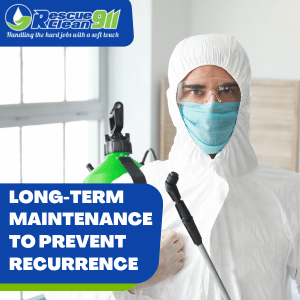 Long-Term Maintenance to Prevent Recurrence
Long-Term Maintenance to Prevent Recurrence
To maintain a healthy, mushroom-free bathroom:
Keep your bathroom regularly dry.
Monitor humidity levels and use dehumidifiers if needed.
Conduct regular inspections for water leaks or moisture issues.
Apply mild disinfectants to eliminate mold and discourage future growth.
Regular upkeep ensures your bathroom remains clean, dry, and free of fungal growth or mushrooms growing in damp corners.
Contact The Pros
Mushrooms in shower areas, if left untreated, can cause serious allergic reactions and respiratory illnesses.
If you are worried about removing it yourself, call Rescue Clean 911 today. We can help you remove the black mold and mushrooms from your home quickly and safely.
We have the experience and expertise necessary to get the job done right. Contact us today for a free consultation when it comes to mushrooms in shower!
The Bottom Line!
By following professional guidelines, using preventative measures, and taking prompt action when mushrooms appear, you can protect your home from structural damage, health risks, and further growth of fungi.
Maintaining adequate ventilation, fixing water leaks, and keeping your bathroom dry and clean are essential steps to prevent mushrooms from returning.
The prevention and removal of mushrooms in shower is a multi-step process that involves addressing moisture issues, ensuring proper ventilation, and maintaining a clean and dry bathroom environment.

